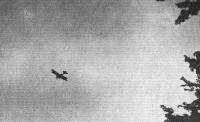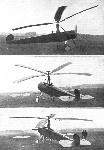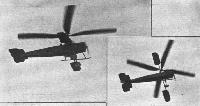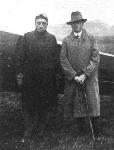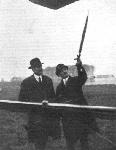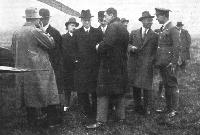Фотографии
-
AN AMERICAN SCHNEIDER CUP DEFENDER: This photograph shows the Army-Curtiss racer on which Lieut. Cyrus Rettis of the U.S. Army Air Service won the Pulitzer race at a speed of 248-99 m.p.h. Similar machines, fitted with floats, will be used as defenders in the Schneider Cup seaplane race.
Самолёты на фотографии: Curtiss R2C / R3C - США - 1923
-
Peering for the Mercians: A Wessex Bristol low over Whitchurch in heavy rain
Самолёты на фотографии: Bristol F.2A/F.2B Fighter - Великобритания - 1916
-
Регистрационный номер: G-EBCP IMPERIAL AIRWAYS' NEW AIR LINER: On Tuesday, October 27, the Vickers "Vanguard," fitted with two Rolls-Royce "Condor" engines of 650 h.p. each, took up a party at the Croydon Aerodrome, when a complete luncheon was served on board. Very bumpy weather somewhat interfered with the enjoyment of the lunch. The machine was piloted by Major H. G. Brackley, Air Superintendent of Imperial Airways, and the Director of Civil Aviation, Air Vice-Marshal Sir Sefton Brancker, acted as "spare pilot." The machine has seating accommodation for twenty passengers, and has a top speed of 112 m.p.h. Our photograph shows (1), front view of the machine; (2), a group of distinguished passengers, including, from left to right, Capt. Acland, Major Mayo, Air Vice-Marshal Sir Sefton Brancker, Major Brackley, and Squadron-Leader Payn. (3), View of the machine in flight, and (4), Side view.
Самолёты на фотографии: Vickers Vanguard / Type 62 / Type 103 - Великобритания - 1923
-
Супермарин S.4 - первый из знаменитых гидросамолетов Р.Митчелла
THE SCHNEIDER CUP RACE: This official photograph of the Supermarine-Napier S.4 admirably shows the very "clean" lines, and it is indeed difficult to see where any head resistance could have been saved. This machine, before going to the United States, established a new world's speed record for seaplanes by flying at an average speed of 226-752 m.p.h.Самолёты на фотографии: Supermarine S.4 - Великобритания - 1925
-
THE BRITISH SCHNEIDER CUP CHALLENGERS: This front view give an excellent idea of the manner in which head resistance has been cut down to a minimum. It was on the Supermarine-Napier S.4 that Capt. Biard established a new world's record for seaplanes by flying at an average speed of 226 752 m.p.h.
Самолёты на фотографии: Supermarine S.4 - Великобритания - 1925
-
THE CIERVA "AUTOGIRO": These three views show admirably the action of the four-bladed lifting screw or windmill. In the lower view the machine is at rest on the ground, and the wings are drooping slightly.Above, the windmill has been started by means of a cable and has acquired a certain amount of speed, the the machine having just started its run. In the top photograph, the machine is seen shortly before "unsticking," the lifting planes having started to rise under the action of the lift. This is particularly noticeable in the wing pointing forward in the first photograph.
Самолёты на фотографии: Cierva/Avro C.6 - Великобритания - 1924
-
THE "AUTOGIRO": Two views of the machine in flight. Note how the high tip speed of the windmill beat our photographer.
Самолёты на фотографии: Cierva/Avro C.6 - Великобритания - 1924
-
THE CIERVA "AUTOGIRO": This photograph shows Capt. Frank Courtney, the pilot of the machine, and Senor de la Cierva, its designer.
Самолёты на фотографии: Cierva/Avro C.6 - Великобритания - 1924
-
THE "AUTOGIRO": Air Vice-Marshal Sir Geoffrey Salmond explaining the principle upon which the machine works to Air Chief Marshal Sir Hugh Trenchard.
Самолёты на фотографии: Cierva/Avro C.6 - Великобритания - 1924
-
THE "AUTOGIRO" DEMONSTRATION: Our group includes, from left to right, Senor J. de la Cierva, the inventor of the "Autogiro," Air Chief-Marshal Sir Hugh Trenchard, Chief of the Air Staff, Mr. C. LI. Bullock, Private Secretary of the Air Minister, Sir Samuel Hoare, Secretary of State for Air, Air Vice-Marshal Sir Geoffrey Salmond, Air Member for Supply and Research, Capt. Frank Courtney, pilot of the "Autogiro," Air Vice-Marshal Sir Sefton Brancker, Director of Civil Aviation, Mr. W. Sydney Smith, Superintendent of the Royal Aircraft Establishment, and Squadron Leader Rollo Haig.
Самолёты на фотографии: Cierva/Avro C.6 - Великобритания - 1924
-
The "Autogiro," piloted by Capt. Courtney, making an almost vertical descent.
Самолёты на фотографии: Cierva/Avro C.6 - Великобритания - 1924
-
The "Autogiro": A close-up view of the supporting mast, hinges and rubber cord top bracing which prevents the wings from drooping.
Самолёты на фотографии: Cierva/Avro C.6 - Великобритания - 1924
-
THE CIERVA "AUTOGIRO": Front view. A mechanic may be seen winding the starting cable around its supports on the wings.
Самолёты на фотографии: Cierva/Avro C.6 - Великобритания - 1924
-
Регистрационный номер: I-DAAK View of the Dornier "Wal," which visited Southampton recently. The photograph shows the machine at rest on the sea
Самолёты на фотографии: Dornier Do.J Wal - Германия - 1922
-
View of the Dornier "Wal," which visited Southampton recently. The photograph shows a view of the nose and the two Rolls-Royce "Eagle" engines.
Самолёты на фотографии: Dornier Do.J Wal - Германия - 1922
-
Prague - Croydon - Prague: Lieut. Jira, of Czechoslovakia, who recently flew from Prague to Croydon and back on an Avia B.H. 9 low-wing monoplane, 60 h.p. Walter engine. Although he did not succeed, owing to bad weather, in making non-stop flights as intended, he nevertheless put up a remarkable performance, covering the 2,525 km. (1,565 miles) at an average speed of 140 k.p.h. (86 9m.p.h.)
Самолёты на фотографии: Avia BH-9 / BH-10 / BH-11 / BH-12 / BH-16 - Чехословакия - 1923
-
THE THIRD PRAGUE AVIATION MEETING: One of three successful competing machines. One of the Avia B.H.10 monoplanes (60 h.p. Walter) which took part in the Sport 'plane race.
Самолёты на фотографии: Avia BH-9 / BH-10 / BH-11 / BH-12 / BH-16 - Чехословакия - 1923
-
"THE CUCKOOS" (No. 25 FIGHTER SQUADRON): "Off in Eight Minutes." Pilots running to their Grebes on receipt of urgent order.
Самолёты на фотографии: Gloster Grebe - Великобритания - 1923
-
TAKING OFF BY FLIGHTS: In eight minutes exactly from receipt of the order the three flights of No. 25 Squadron were in the air
Самолёты на фотографии: Gloster Grebe - Великобритания - 1923
-
No. 56 Fighter Squadron off on a mission
Самолёты на фотографии: Gloster Grebe - Великобритания - 1923
-
THE RETURN AND THE DISPERSE: No. 25 has accomplished its mission
Самолёты на фотографии: Gloster Grebe - Великобритания - 1923
-
THE RETURN AND THE DISPERSE: Letting off Steam. After breaking formation the pilots of No. 25 display a little individuality.
Самолёты на фотографии: Gloster Grebe - Великобритания - 1923
-
THE SCHNEIDER CUP RACE: This official photograph of the Gloster-Napier III gives a very good idea of the general design. Noteworthy features are the very careful streamlining and the small size of the machine in relation to its floats.
Самолёты на фотографии: Gloster I - III - Великобритания - 1923
-
THE BRITISH SCHNEIDER CUP CHALLENGERS: This front view give an excellent idea of the manner in which head resistance has been cut down to a minimum.
Самолёты на фотографии: Gloster I - III - Великобритания - 1923
-
Регистрационный номер: N194 THE SCHNEIDER CUP RACE: This side view of the British challenger, the Gloster-Napier III
Самолёты на фотографии: Gloster I - III - Великобритания - 1923
-
Macchi M.33 Curtiss D.12 Engine
Самолёты на фотографии: Macchi M.33 - Италия - 1925
-
Регистрационный номер: G-EBLE The Handley Page "Hampstead" arriving at Farnborough from Croydon.
Самолёты на фотографии: Handley Page Hamilton W.8e/H.P.26 / Hampstead W.9/H.P.27 - Великобритания - 1924
-
THE HANDLEY PAGE "HAMPSTEAD": Some detail features. 1 shows the front portion of the saloon, with instruments, sliding panel leading to pilot's cockpit, and net racks. The tubes of these serve as diffuser boxes for the fresh air. In 2 are seen the ripping panels in the roof, while 3 shows the special door handle of the luggage compartment, designed to facilitate sealing by Customs officials. 4 gives details of the compression rubber springing, and 5 shows the ladder to the cockpit, the starting handle for the front engine, and the hot-air muff around the exhaust pipe.
Самолёты на фотографии: Handley Page Hamilton W.8e/H.P.26 / Hampstead W.9/H.P.27 - Великобритания - 1924
-
Handley Page W.9 "Hampstead" 3-385 hp Armstrong-Siddeley "Jaguar" Mk.IV Engines.
Самолёты на фотографии: Handley Page Hamilton W.8e/H.P.26 / Hampstead W.9/H.P.27 - Великобритания - 1924
-
Bristol "Cherub" in Germany: At the recent International meeting at Munich, the Messerschmitt M.17 monoplane, fitted with Bristol "Cherub" engine, obtained first place in both the altitude and the speed competitions, and, according to Herr Messerschmitt, the "Cherub" "ran like clockwork from beginning to end of the competitions." The pilot was Herr Karl Croneiss.
Самолёты на фотографии: Messerschmitt S15 / S16 / M.17 - Германия - 1923
-
THE ALBATROS L.69: This front view shows the clean lines of the machine, and the cowling of the Bristol "Lucifer" engine.
Самолёты на фотографии: Albatros L.69 - Германия - 1925
-
THE ALBATROS L.69: Three-quarter rear view. The fuselage comes to a point at the back, this cone being detachable so as to give access to the control levers, etc.
Самолёты на фотографии: Albatros L.69 - Германия - 1925
-
Albatros L.69 100 hp. Bristol "Lucifer" Engine
Самолёты на фотографии: Albatros L.69 - Германия - 1925
-
THE THIRD PRAGUE AVIATION MEETING: One of three successful competing machines. The Avia B.H.21 (300/380 h.p. Supercharged Hispano-Suiza), which won the 200-km. speed contest with 250 kgs. load.
Самолёты на фотографии: Avia BH-21 / BH-22 / BH-23 - Чехословакия - 1925
-
THE THIRD PRAGUE AVIATION MEETING: One of three successful competing machines. The Avia B.H.21R (300/380 h.p. Hispano-Suiza) racer and Pilot Fritsch, winners of the "President's Race."
Самолёты на фотографии: Avia BH-21 / BH-22 / BH-23 - Чехословакия - 1925
Статьи
- Flight

